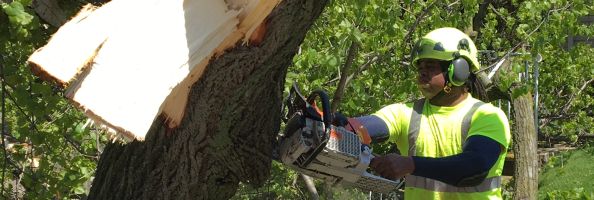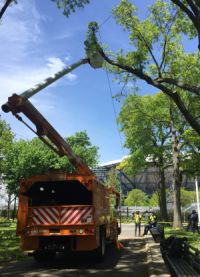Managing Tree Risk

As the stewards of New York City’s urban forest, we care for our city’s street and park trees and also respond to more than 80,000 forestry-related service requests from concerned New Yorkers each year. To help keep our tree canopy healthy and safe, we’re integrating modern tree risk management practices into the way we care for our urban forest.
Tree Risk Management Enhances Public Safety and Urban Forest Health
On July 1, 2017 we launched a pilot program to better evaluate our trees in keeping with the latest industry standards set by the International Society of Arboriculture (ISA) and the American National Standards Institute (ANSI). Through applying our professional expertise in risk management, we’ll address the conditions that present the highest risk to public safety and property before other work.
What This Means for Our Tree Work
Through this program, we’ll be inspecting trees and identifying concerns before they become major problems, and performing more systematic and preventive tree care. We’ll be incorporating both public service requests and forward-looking routine tree inspections into a system that will help prioritize our work.
We’ll address high priority work, including work on trees in parks, before lower priority tree conditions. We also anticipate addressing hanging, dead, and diseased limb conditions more frequently. This means that some smaller, low-risk dead trees will remain in place longer than in the past. We believe these changes will improve the overall health and safety of our forests, our city, and our residents.
How Tree Risk Management Works
Our tree risk management program sets priorities for each tree based upon the results of inspections, including those made from your service requests.
Your Service Requests
We will continue to inspect and respond to tree conditions submitted by the public. The service request process consists of three steps.
- Submitting a Service Request: When you make a tree service request, whether by calling 311 (212-NEW-YORK), by finding your tree on the NYC Street Tree Map, or by visiting our Tree Services web page, we’ll send a trained arborist to inspect the site.
- Inspecting the Tree: We’ll inspect the tree within a timeframe established by the type of condition reported. If the tree is found to need work, we’ll create an order to perform the work. We’ll let you know by email, or you can check the status of your request through 311 Online.
- Performing the Work: If the inspection has led to a work order, we’ll perform the work on the tree in order of priority. Priority is based on our inspection criteria listed below. We will address all conditions in need of immediate attention first. As we launch our pilot program, we will further develop our standards for addressing lower-priority work.

Our Risk Inspection Criteria
Our inspectors will take three factors into account to determine the level of risk posed by a tree or branch and assign a tree priority ranking.
- Likelihood of Tree Failure: Our inspectors look at the structural conditions of a tree that may lead to failure, including broken or hanging branches, cracks in the trunk or branches, or dead or dying parts of the tree.
- Likelihood of Impact: After assessing the likelihood of a tree failure, our expert tree risk assessors categorize the chance of a tree impacting people, buildings, animals, infrastructure, vehicles, and landscapes. For inspectors, the most important situations to assess are locations where people are frequently present.
- Consequences of Impact: Inspectors must also assess the consequences of the tree or part of tree failing and the injury, damage, or harm that could be caused by such an event. Inspectors take into consideration elements such as the size of the tree or limb, and the distance and characteristics of the potential fall.
If a tree is found to need continued monitoring and assessment, we’ll re-inspect or re-visit it. And our trained inspectors will continue to respond to service requests called in by the public.
Our risk management program has adapted ISA’s Tree Risk Management Best Management Practices (BMPs), which are based on the ANSI standard for Tree Risk Management (ANSI A300 (Part 9)-2011).
About Our Inspectors
We conduct tens of thousands of inspections on our trees every year. Our inspectors are urban forestry professionals, many of whom have advanced certifications from the International Society of Arboriculture (I.S.A.). We inspect street trees and trees in parks both through our regular block pruning program, as well as through requests from our staff and from members of the public.
Severe Weather Conditions
Our new tree risk management program will not affect our response to severe weather. The first priority for NYC Parks during a major storm event will continue to be safety. All storm damaged trees will be secured and cleared from the public rights of way.
Visit our Trees and Severe Weather Page
More Information
Interested in learning more about tree risk management? Visit the United States Department of Agriculture’s site to read USDA - Urban Tree Risk Management: A Community Guide to Program Design and Implementation.